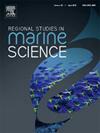印度马纳尔湾戈麦斯普兰水道有害工业废水的空间变化和环境风险
IF 2.1
4区 环境科学与生态学
Q3 ECOLOGY
引用次数: 0
摘要
本研究首次调查了印度马纳尔湾的戈麦斯普兰水道水质的空间变化。采用标准方法对2022年10月至11月采集的水样进行评价。由于高盐藻类(Dunaliella sp.)的出现,河道已变成粉红色,表明不同未经处理的盐田和海鲜加工厂排放了大量废水。通过分子表征首次在河道中鉴定并确认了绿藻Dunaliella salina (OR772295)、假盐藻Dunaliella pseudosalina (OR772296)和叔盐藻Dunaliella tertiolecta (OR772297)。本次调查的水质指数(WQI)表明,沿海水道监测和管理较差,不适合人类消费。箱形图比较了采样点的所有参数,以了解环境数据的空间变化和分布。Pearson’s correlation显示相关变量,如TSS和TDS与色素浓度之间存在较强的正相关关系,说明这些参数同时增加或减少。双向层次分析直观地表明,站3、4和5表现出相似的水质剖面,而站1表现出不同的特征,可能是由于局部污染。该研究通过说明该水道水质状况的空间差异和造成水变色的人为来源,为管理提供了有益的信息。本文章由计算机程序翻译,如有差异,请以英文原文为准。
Spatial variation and environmental risk of hazardous industrial effluents in the Gomezpuram Water Channel, Gulf of Mannar, India
This study investigated the Gomezpuram Water Channel in the Gulf of Mannar, India, for the first time regarding spatial variations in water quality. Standard methods were adopted to evaluate water samples collected between October and November 2022. Due to the manifestation of hypersaline algae (Dunaliella sp.), the water channel has turned pink, indicating a considerable effluent discharge from different untreated salt pans and seafood processing plants. Green a lgae Dunaliella salina (OR772295), Dunaliella pseudosalina (OR772296), and Dunaliella tertiolecta (OR772297) were identified and confirmed through molecular characterization in the water channel for the first time. The present investigation's Water Quality Index (WQI) shows that the coastal water channel was poorly monitored, managed, and unsuitable for human consumption. A box plot compares all parameters across sampling sites to comprehend environmental data's spatial variation and distribution. Pearson's correlation shows strong positive correlations between related variables, such as TSS and TDS, and pigment concentration, indicating that these parameters increase or decrease together. A Two-way hierarchical analysis visually represents those stations 3, 4, and 5 exhibit similar water quality profiles, whereas station 1 shows distinct characteristics, likely due to localized pollution. This study provides helpful information for management purposes by illustrating the spatial differences in the water quality condition and the anthropogenic sources causing water discoloration in this water channel.
求助全文
通过发布文献求助,成功后即可免费获取论文全文。
去求助
来源期刊

Regional Studies in Marine Science
Agricultural and Biological Sciences-Ecology, Evolution, Behavior and Systematics
CiteScore
3.90
自引率
4.80%
发文量
336
审稿时长
69 days
期刊介绍:
REGIONAL STUDIES IN MARINE SCIENCE will publish scientifically sound papers on regional aspects of maritime and marine resources in estuaries, coastal zones, continental shelf, the seas and oceans.
 求助内容:
求助内容: 应助结果提醒方式:
应助结果提醒方式:


